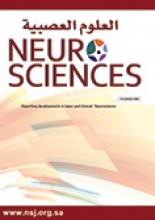Abstract
OBJECTIVE: There is paucity of information on the driving pattern of epileptic patients in Saudi Arabia. The purpose of this study was to document the frequency of epileptic patients that drive and the factors associated with this.
METHODS: A Hospital-based study with structured interviews of consecutively recruited patients who gave prior consent. Seizure types, extent of control and factors presumed to be associated with driving were documented.
RESULTS: One hundred and thirty eight male epileptics (mean age: 32.7 years) were studied. Only 15 patients (11%) were not driving. There was no difference in the mean ages of those who drove and those who did not (t = 0.69, p = 0.49); but the former group had a significantly higher proportion of subjects with uncontrolled seizures (z = 2.52, p<0.01). Overall, 108 subjects (78%) were educated about the risks associated with driving. The major reason for driving was seizure control with no fear of accidents. The other reasons were: lack of money to employ drivers and non availability of other people to drive. On multivariate analysis, seizure control and negative history of attack while driving were the factors significantly associated with driving.
CONCLUSION: The study showed a very high frequency of epileptic drivers whose decision to drive appeared to be associated with good seizure control and lack of attacks while driving. Health education about the risk of driving should continue especially for patients with uncontrolled attacks and generalized seizures.
- Copyright: © Neurosciences
Neurosciences is an Open Access journal and articles published are distributed under the terms of the Creative Commons Attribution-NonCommercial License (CC BY-NC). Readers may copy, distribute, and display the work for non-commercial purposes with the proper citation of the original work.






